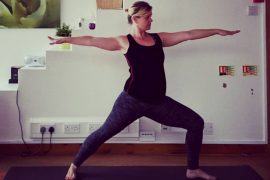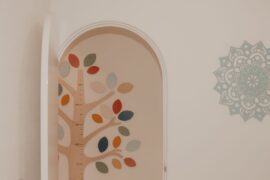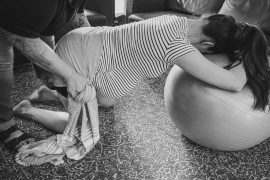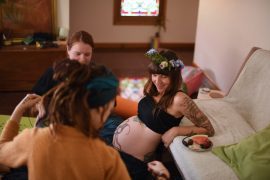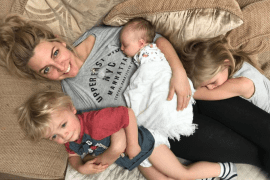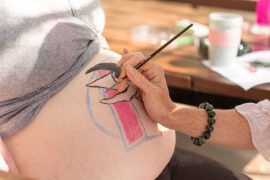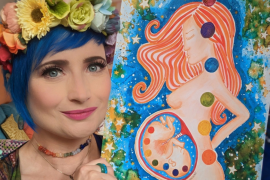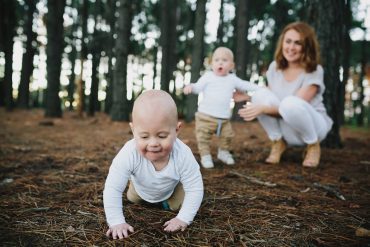Gav and I decided not to have any medical interventions through my pregnancy and birth, including ultrasounds, blood work or internal examinations during labour, deciding to let nature run its course. It’s not that I’m against any of these interventions, and understand that in some cases it is necessary. We chose to give birth at my parents’ home in Melbourne and selected our midwife on her reassurance that she would not intervene unless absolutely necessary. Throughout the pregnancy I practised Vipassana meditation and sat through two extended courses. Vipassana teaches us to observe sensation and observe your reactions to external influences, in turn shrinking the emotional ‘scar tissue’ which can build up around stress. It was also an amazing way for me to tune into my baby.
Our approach didn’t follow the conventional pregnancy and birth. As a consequence, it was met by others’ fears: “How do you know if the baby is normal?” to “What if it is too big to fit?” and “Do you really think you should be doing that?”. We researched as best we could and weighed up the risks versus the benefit. In the end, we were prepared to take responsibility for our own decisions.

The labour
I was so curious as to how labour would feel and at 37 weeks and 6 days I found out. I always thought that our baby would come ‘early’. I woke at 4am and thought my water had broken, before going back to sleep and waking at 6.30 to meditate. We called our midwife at 11am to tell her my water had broken but I felt no contractions. She advised that I should go into labour over the next 24 to 48 hours. At 4pm we heard a pop and lots of fluid gushed out. My belly began to tighten at times but still no pain. At 7pm we sat through a movie while I told Gav when I felt my belly tighten and relax. I didn’t want to be made aware of times, so he recorded everything. At this time, they were 6-8 minutes apart lasting 30-60 seconds. At 9pm we decided to meditate again. I could feel my legs shaking, however the meditation settled me. Gav applied acupressure on my back during contractions which helped me relax. Meditation continued to help me view everything as sensation and not pain. Gav filled the spa so I had the option for a water birth if I wanted it.
I had read Hypnobirthing while pregnant, however I wasn’t sure if I’d use any of the techniques, as meditation felt more familiar to me. I did use one technique during this time: visualising the uterus tightening and opening the cervix over the baby’s head. At this stage my contractions were two to three minutes apart but I was still unsure if I really was in labour. At 10.45pm I vomited and asked Gav to call our midwife, who arrived at 11.45pm. My birth plan stated I wanted to be left alone with just Gav and our midwife respected our wishes and stayed in the room next door; however, I changed my mind and asked her to sit quietly in the room with us. I kept waiting for the sensation of transition to come up: the feeling of being ‘over it’ or wanting pain relief. As none of this came up, I thought I had a long way to go. At about 1am I felt an urge to bear down but not push. Hesitantly, I asked our midwife how she thought it was all going and she told me she thought the baby was almost here. She said I could check and I felt our baby’s head less than a couple of centimetres away. The bearing down wasn’t painful and actually felt really good! I talked to my body and the baby during contractions, and at this stage was falling asleep between contractions.
When I felt the baby crowning I came to peace with allowing the head to come down, stretch a little, then move back a little. I allowed this to happen through a few contractions, before the baby crowned, her body then shooting out, hand over head. Gav was the first to touch and hold our baby and passed her to me through my legs. Our Violet was born a minute after my own birth time.

Lotus birth
We chose a lotus birth – keeping the placenta attached until it naturally fell away. This was for spiritual reasons as well as physiological – there’s a lot of research around the nutrients that continue to feed the baby after it’s born and we felt this lifeline had been like a teddy bear to our daughter though pregnancy. We kept the placenta in its own nappy and salted it regularly to preserve it. If you’re not keen on a lotus birth, I recommend at least looking into delayed cord clamping, so your baby can continue to receive the blood and nutrients from the placenta.
I am infamously bad with pain and after reading a few stories of painless birth, I wondered if it was really possible. Honestly, it is. I did experience a second-degree tear but thankfully it didn’t require stitching and completely healed by itself. It did affect me psychologically, but my midwife and Traditional Chinese Medicine helped me through this.
We planned 7 to 10 days ‘confinement’ after the birth. We didn’t want any visitors, to allow us time to recover, to bond and give all our attention to our new baby. We feel that this time was incredibly valuable; Violet was so calm and peaceful. After five days, her umbilical cord detached and her placenta separated.
Two weeks after giving birth, I wrote down everything I remembered about the experience whilst it was still fresh. I feel like this was super beneficial to look back on and also to integrate the experience further. I highly recommend you do the same thing – you might be delighted in finding it in years to come, and amazed by all the little details that time washes away.
I’m so grateful to be able to share my birth experience, for others to see what’s possible for them. Your experience can be vastly influenced by your choices and the team you surround yourself with. It’s never too early to prepare and the earlier you explore your options, the greater the outcome can be. I work in a community of practitioners who all communicate and refer clients to each other: from pelvic health physiotherapists to hypnobirthing experts, naturopaths and yoga teachers. Our job is to celebrate your choices and support you on your journey. Trust yourself, ask for support and search for the options that fill you with joy.
Jin sees patients at MetaMed in Wanaka and loves to support women through their pregnancy journey with treatment, herbs, acupuncture and supportive advice. She also holds workshops and events with like-minded practitioners, teaches treatment techniques and runs retreats.
If you would like to work with Jin head to metamed.co.nz or email jin@metamed.co.nz .
For Jin’s recommended advice of natural therapies to support you through different stages of pregnancy, head to this blog post.
For the upcoming Positive Pregnancy, Birth & Post-Natal Transition fundraising event on 22nd February in Queenstown, head to the Metamed Facebook page.
Jin Ong is an Osteopath, Herbalist, Western Medical Acupuncturist and Psychosomatic Therapist based in New Zealand’s gorgeous Wanaka. With osteopathy clinics in both Wanaka and Queenstown, Jin is passionate about empowering women to own their birth story and take control of their experience and believes fervently in the power of story sharing so others know what is possible. Visit the Metamed website for more info or check out Jin’s Facebook, Instagram and LinkedIn pages.

